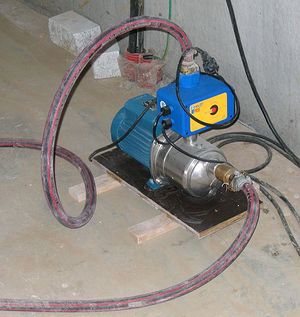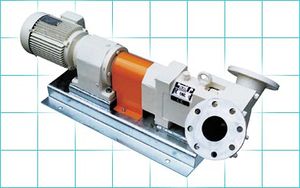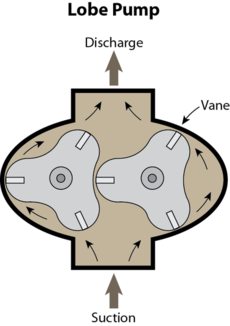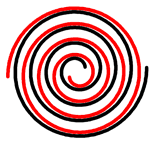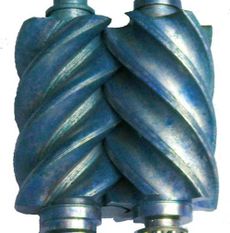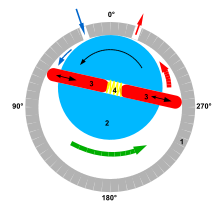Difference between revisions of "Pumps"
| Line 17: | Line 17: | ||
[[Image:Two_moving_spirals_scroll_pump.gif|thumb|Mechanism of a scroll pump]] | [[Image:Two_moving_spirals_scroll_pump.gif|thumb|Mechanism of a scroll pump]] | ||
A positive displacement pump | A positive displacement pump uses pressure`s to move by trapping a fixed amount of it and then forcing (displacing) that trapped volume into the discharge pipe. | ||
Some positive displacement pumps work using an expanding cavity on the suction side and a decreasing cavity on the discharge side. | Some positive displacement pumps work using an expanding cavity on the suction side and a decreasing cavity on the discharge side. powders flow into the pump as the cavity on the suction side expands and the powders flow out of the discharge as the cavity collapses. The volume is constant given each cycle of operation. | ||
==== Positive Displacement Pump behavior and safety ==== | ==== Positive Displacement Pump behavior and safety ==== | ||
| Line 30: | Line 30: | ||
==== Positive Displacement Types ==== | ==== Positive Displacement Types ==== | ||
[[Image:Lysholm_screw_rotors.jpg|thumb|upright|Screw pump]] | [[Image:Lysholm_screw_rotors.jpg|thumb|upright|Screw pump]] | ||
A positive displacement pump can be further classified according to the mechanism used to move the | A positive displacement pump can be further classified according to the mechanism used to move the powder: | ||
* '''Rotary-type''' positive displacement: internal gear, screw, shuttle block, flexible vane or sliding vane, circumferential piston, helical twisted roots | * '''Rotary-type''' positive displacement: internal gear, screw, shuttle block, flexible vane or sliding vane, circumferential piston, helical twisted roots | ||
* '''Reciprocating-type''' positive displacement: piston or diaphragm pumps. | * '''Reciprocating-type''' positive displacement: piston or diaphragm pumps. | ||
* '''Linear-type''' positive displacement: Rope pump|rope pumps and chain pumps. | * '''Linear-type''' positive displacement: Rope pump|rope pumps and chain pumps. | ||
| Line 42: | Line 42: | ||
'''Advantages:''' Rotary pumps are very efficient because they naturally remove air from the lines, eliminating the need to bleed the air from the lines manually. | '''Advantages:''' Rotary pumps are very efficient because they naturally remove air from the lines, eliminating the need to bleed the air from the lines manually. | ||
'''Drawbacks:''' Positive displacement rotary pumps also have their weaknesses. Because of the nature of the pump, the clearance between the rotating pump and the outer edge must be very close, requiring that the pumps rotate at a slow, steady speed. If rotary pumps are operated at high speeds, the | '''Drawbacks:''' Positive displacement rotary pumps also have their weaknesses. Because of the nature of the pump, the clearance between the rotating pump and the outer edge must be very close, requiring that the pumps rotate at a slow, steady speed. If rotary pumps are operated at high speeds, the powders will cause erosion. | ||
Rotary positive displacement pumps can be grouped into three main types: | Rotary positive displacement pumps can be grouped into three main types: | ||
* [[Gear Pumps]] - a simple type of rotary pump where the | * [[Gear Pumps]] - a simple type of rotary pump where the powder is pushed between two gears. | ||
* [[Screw Pumps]] - the shape of the internals of this pump usually two screws turning against each other pump the | * [[Screw Pumps]] - the shape of the internals of this pump usually two screws turning against each other pump the powders. | ||
* [[Rotary Vane Pumps]] - similar to scroll compressors, consisting of a cylindrical rotor encased in a similarly shaped housing. As the rotor turns, the vanes trap fluid between the rotor and the casing, drawing the | * [[Rotary Vane Pumps]] - similar to scroll compressors, consisting of a cylindrical rotor encased in a similarly shaped housing. As the rotor turns, the vanes trap fluid between the rotor and the casing, drawing the powder through the pump. | ||
===== Reciprocating Positive Displacement Pumps ===== | ===== Reciprocating Positive Displacement Pumps ===== | ||
Reciprocating-type pumps require a system of suction and discharge valves to ensure that the | Reciprocating-type pumps require a system of suction and discharge valves to ensure that the powder moves in a positive direction. Pumps in this category range from having "simplex" one cylinder, to in some cases "quad" (four) cylinders or more. Most reciprocating-type pumps are "duplex" (two) or "triplex" (three) cylinder. Furthermore, they can be either "single acting" independent suction and discharge strokes or "double acting" suction and discharge in both directions. The pumps can be powered by air, steam or through a belt drive from an engine or motor. This type of pump was used extensively in the early days of steam propulsion (19th century) as boiler feed water pumps. | ||
These positive displacement pumps have an expanding cavity on the suction side and a decreasing cavity on the discharge side. | These positive displacement pumps have an expanding cavity on the suction side and a decreasing cavity on the discharge side. powders flow into the pumps as the cavity on the suction side expands and the powders flow out of the discharge as the cavity collapses. The volume is constant given each cycle of operation. | ||
Typical reciprocating pumps are: | Typical reciprocating pumps are: | ||
* [[Plunger Pumps]] - a reciprocating plunger pushes the | * [[Plunger Pumps]] - a reciprocating plunger pushes the powder through one or two open valves, closed by suction on the way back. | ||
* [[Diaphragm Pumps]] - similar to plunger pumps, where the plunger pressurizes hydraulic oil which is used to flex a diaphragm in the pumping cylinder | * [[Diaphragm Pumps]] - similar to plunger pumps, where the plunger pressurizes hydraulic oil which is used to flex a diaphragm in the pumping cylinder. | ||
| Line 68: | Line 68: | ||
* [[Progressive Cavity Pumps]] | * [[Progressive Cavity Pumps]] | ||
* [[Gear Pumps]] | * [[Gear Pumps]] | ||
* [[Diaphragm Pumps]] | * [[Diaphragm Pumps]] | ||
* [[Screw Pumps]] | * [[Screw Pumps]] | ||
Revision as of 04:43, 15 March 2012
A pump displaces a volume by physical or mechanical action. Pumps fall into three major groups: direct lift, displacement, and gravity pumps.
Types
Positive Displacement Pumps
A positive displacement pump uses pressure`s to move by trapping a fixed amount of it and then forcing (displacing) that trapped volume into the discharge pipe.
Some positive displacement pumps work using an expanding cavity on the suction side and a decreasing cavity on the discharge side. powders flow into the pump as the cavity on the suction side expands and the powders flow out of the discharge as the cavity collapses. The volume is constant given each cycle of operation.
Positive Displacement Pump behavior and safety
Positive displacement pumps, unlike centrifugal or roto-dynamic pumps, will in theory produce the same flow at a given speed (RPM) no matter what the discharge pressure. Thus, positive displacement pumps are constant flow machines. However due to a slight increase in internal leakage as the pressure increases, a truly constant flow rate cannot be achieved.
A positive displacement pump must not be operated against a closed valve on the discharge side of the pump, because it has no shut-off head like centrifugal pumps. A positive displacement pump operating against a closed discharge valve will continue to produce flow and the pressure in the discharge line will increase, until the line bursts or the pump is severely damaged, or both.
A relief or safety valve on the discharge side of the positive displacement pump is therefore necessary. The relief valve can be internal or external. The pump manufacturer normally has the option to supply internal relief or safety valves. The internal valve should in general only be used as a safety precaution, an external relief valve installed in the discharge line with a return line back to the suction line or supply tank is recommended.
Positive Displacement Types
A positive displacement pump can be further classified according to the mechanism used to move the powder:
- Rotary-type positive displacement: internal gear, screw, shuttle block, flexible vane or sliding vane, circumferential piston, helical twisted roots
- Reciprocating-type positive displacement: piston or diaphragm pumps.
- Linear-type positive displacement: Rope pump|rope pumps and chain pumps.
Rotary Positive Displacement Pumps
Positive displacement rotary pumps are pumps that move fluid using the principles of rotation. The vacuum created by the rotation of the pump captures and draws in the liquid.
Advantages: Rotary pumps are very efficient because they naturally remove air from the lines, eliminating the need to bleed the air from the lines manually.
Drawbacks: Positive displacement rotary pumps also have their weaknesses. Because of the nature of the pump, the clearance between the rotating pump and the outer edge must be very close, requiring that the pumps rotate at a slow, steady speed. If rotary pumps are operated at high speeds, the powders will cause erosion.
Rotary positive displacement pumps can be grouped into three main types:
- Gear Pumps - a simple type of rotary pump where the powder is pushed between two gears.
- Screw Pumps - the shape of the internals of this pump usually two screws turning against each other pump the powders.
- Rotary Vane Pumps - similar to scroll compressors, consisting of a cylindrical rotor encased in a similarly shaped housing. As the rotor turns, the vanes trap fluid between the rotor and the casing, drawing the powder through the pump.
Reciprocating Positive Displacement Pumps
Reciprocating-type pumps require a system of suction and discharge valves to ensure that the powder moves in a positive direction. Pumps in this category range from having "simplex" one cylinder, to in some cases "quad" (four) cylinders or more. Most reciprocating-type pumps are "duplex" (two) or "triplex" (three) cylinder. Furthermore, they can be either "single acting" independent suction and discharge strokes or "double acting" suction and discharge in both directions. The pumps can be powered by air, steam or through a belt drive from an engine or motor. This type of pump was used extensively in the early days of steam propulsion (19th century) as boiler feed water pumps.
These positive displacement pumps have an expanding cavity on the suction side and a decreasing cavity on the discharge side. powders flow into the pumps as the cavity on the suction side expands and the powders flow out of the discharge as the cavity collapses. The volume is constant given each cycle of operation.
Typical reciprocating pumps are:
- Plunger Pumps - a reciprocating plunger pushes the powder through one or two open valves, closed by suction on the way back.
- Diaphragm Pumps - similar to plunger pumps, where the plunger pressurizes hydraulic oil which is used to flex a diaphragm in the pumping cylinder.
Various Positive Displacement Pumps
The positive displacement principle applies in the following types of pumps:
- Lobe Pumps
- Progressive Cavity Pumps
- Gear Pumps
- Diaphragm Pumps
- Screw Pumps
- Gear Pumps
- Hydraulic Pumps
- Vane Pumps
- Regenerative Pumps
- Peristaltic Pumps
- Rope Pumps
Impulse Pumps
Impulse pumps use pressure created by gas (usually air). In some impulse pumps the gas trapped in the liquid (usually water), is released and accumulated somewhere in the pump, creating a pressure which can push part of the liquid upwards. Impulse pumps include:
- Hydraulic ram pumps - uses pressure built up internally from released gas in liquid flow. (see below)
- Pulser pumps - run with natural resources, by kinetic energy only.
- Airlift pumps - run on air inserted into pipe, pushing up the water, when bubbles move upward, or on pressure inside pipe pushing water up.
Velocity Pumps
Rotodynamic Pumps (or dynamic pumps) are a type of velocity pump in which kinetic energy is added to the fluid by increasing the flow velocity. This increase in energy is converted to a gain in potential energy (pressure) when the velocity is reduced prior to or as the flow exits the pump into the discharge pipe. This conversion of kinetic energy to pressure can be explained by the First law of thermodynamics or more specifically by Bernoulli's principle.
Dynamic pumps can be further subdivided according to the means in which the velocity gain is achieved.
These types of pumps have a number of characteristics:
- Continuous energy
- Conversion of added energy to increase in kinetic energy (increase in velocity)
- Conversion of increased velocity (kinetic energy) to an increase in pressure head
One practical difference between dynamic and positive displacement pumps is their ability to operate under closed valve conditions. Positive displacement pumps physically displace the fluid; hence closing a valve downstream of a positive displacement pump will result in a continual build up in pressure resulting in mechanical failure of either pipeline or pump. Dynamic pumps differ in that they can be safely operated under closed valve conditions (for short periods of time).
